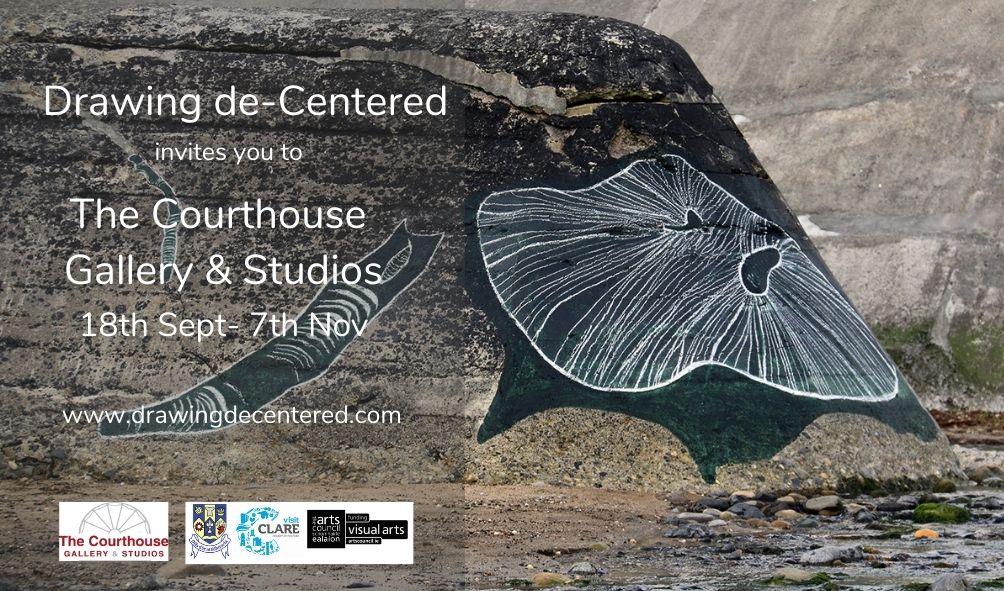|
PRESS RELEASE Drawing de-Centered: The Courthouse, Ennistymon. Preview: 18th September Virtual Opening: 26th September Run Dates: 19th September - 7th November Drawing de-Centered (DdC) is a diverse, nomadic and emerging artistic platform that explores contemporary drawing practice. DdC aims to provoke and probe drawings intrinsic and expanding qualities. Characterised by openness, embodiment, and liminality, Drawing deCentered focus on critical thinking around drawing practice and questions what drawing is but also what can drawing be. In this exhibition of the same name Drawing deCentered, a multiplicity of practices and research interests together with a wide-range of materialities that include but not limited to, the humble pencil on paper to neon lights to natural drawing materials emphasise DdC’s strength. Racheal Agnew and Kiera O’Toole’s practice share a central concern of drawing and phenomenology in relation to site. Agnew explores transitional spaces while O’Toole examines the atmospheric, material, temporal and corporeal aspects of human experience. Mary-Ruth Walsh offers an exploration into the gap that exist between 2D and 3D spaces particularly architectural spaces. Felicity Clear also considers the transition from 2D to 3D through traditional and non-traditional media. Kevin Killen’s practice captures individual’s journeys and movements through light while Melissa O’Faherty’s interest lies the intersection of humanities impact on nature. Drawing de-Centred has recently shown with international Dutch artists in ‘Beyond Drawing’ curated by Arno Kramer and reviewed by Clare E. Scott in Visual Arts Ireland News Sheet. July 2020. https://www.drawingdecentered.com/beyond-drawing.html Drawing de-Centred is exhibiting in The Courthouse, Ennistymon, Co Clare with the following artists: Rachael Agnew / Mary-Ruth Walsh / Kiera O’Toole / Kevin Killen / Melissa O’Faherty / Felicity Clear Rachael Agnew Agnew's practice centres around the phenomenology of interstitial spaces. This is defined here as the subjective experience of empty, between, intermediate and transitional spaces. Her work takes the form of site-specific drawing installations and interventions. Movement, light and transparency are key elements in creating and perceiving her works. Mary-Ruth Walsh My practice explores public spaces from frenetic airports and shopping centres to the desolate loneliness of empty spaces. In public and domestic spaces it’s fascinating to see how architecture affects the way we move and behave. I’m curious about the gap between the two dimensional drawing or blueprint of a building and the three dimensional materiality of the realisation of that building. What happens in that gap between the object and its two-dimensional representation is full of promises and denials, of realities and unrealities. The drawings and blueprints are a deliberate exercise of improbability and possibility. But the subtext is also about the substitution of real experience or real time. Kiera O’Toole Why (the Site of) Drawing Matters...to me. My practice examines how humans experience the world and how the things in our world affect us as they resound in our bodies, always and already. I'm deeply concerned about the atmospheric, material, temporal and corporeal aspects of the experience which forms and informs my drawing practice. The embodied mark and all its complexities: diversity, directness, universality and presentness is evidence of human existence. It's a way to experience the world and to pay attention to the everyday. My hope is to create a 'Holding Space' for a shared experience between the viewer, the drawing and the site - which maybe an art space or a non-art space or a rural or urban environment By paying attention to our intuitive and felt sense of experience, we can become aware of the intersubjective here and now. Kevin Killen My practice involves capturing life through studying people’s physical space and the journeys or movements they make. Very often I physically walk a route myself, filming long-exposures that ‘draw’ the journey in light. I use more traditional drawing tools to translate the journey lines using the medium of neon light that captures moments in space and time. Melissa O’Faherty Of particular interest to O’Faherty’s drawing practice is the phenomenon in nature and reflections of humanity's influence and attempts to control our natural environment. ‘I'm interested in how combining photography and drawing and might direct the viewer to an exposure of the subject matter. My work is also concerned with drawing images revealing themselves through the making process of the automatism technique, the art-making process where the subconscious is allowed to create’. Felicity Clear My practice involves the intersection of line, light and perception. Drawing in a variety of mediums and in various scales is at the core. From small two-dimensional works on paper to large sculptural installations and hand drawn animation. The provisional nature of drawing and its other technical role in engineering, architecture and everyday life are central reference points. Often perspective is skewed and three-dimensional elements cast shadows which present visual conundrums. As Francis Halsall says in ‘Drawing the line’ in Irish Arts Review autumn 2019: ‘Given the priority that Clear gives to line, the work is often suggestive of the aesthetic forms of infrastructure, alluding as they do to maps, plans, scaffoldings and support structures. Through these allusions to infrastructure, her meticulous and intricate constructions become highly effective metaphors for the systems that are ubiquitous in everyday life’.
0 Comments
|
AuthorNotes, Articles, Reviews Archives
April 2023
Categories |

 RSS Feed
RSS Feed